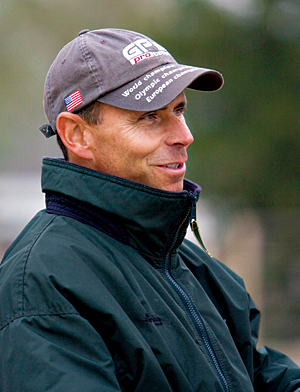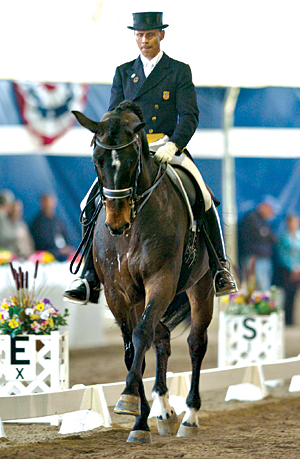In this series, the Chronicle follows six riders as they seek to fulfill their Olympic dreams in Hong Kong in 2008. Click here to read Steffen’s first installment.
Things look pretty good so far. Ravel did exactly what I was hoping for. So far, he’s put in six very clean tests and has been focused in the ring. For him to be No. 1 at the first three CDIs, the first three shows
that I’ve ridden him in, it’s looking great.
 I knew he was a fantastic horse. Everybody on the Peters team knew he was a fantastic horse. But it was a happy surprise that he pulled it off six times in a row.
I knew he was a fantastic horse. Everybody on the Peters team knew he was a fantastic horse. But it was a happy surprise that he pulled it off six times in a row.
Klaus [Balkenhol, team coach] saw him last week, and he sat there for the first 15 minutes and just watched him. He first saw Ravel at Edward Gal’s place. He rode him, and he wasn’t all that convinced. He said the flying changes were going to be a problem. I agreed with him, but I thought it was something that could come with confidence.
Last week he said, “I’m glad to tell you that I’m happily surprised at the way he looks. I didn’t expect for Ravel to come around that quickly.”
He was pleased with all the movements. He agrees with the judges when they said that his strength is that he doesn’t have any weaknesses.
Ravel also did a really nice freestyle at the last show. The music didn’t seem to bother him. I’ve schooled him here and there at night under the lights at the shows, and so far, things look good.
But I’m realistic about it. He still has to do the same exact performances that he’s done before for two weekends in a row in June [at the U.S. Dressage Selection Trials, June 21-22 and June 28-29, in San Juan Capistrano, Calif.].
Let’s not forget that the Patriots lost the Super Bowl after winning a lot of games. I’m fully aware that one never should take this for granted. I always like to ride the next show as if I was in the middle of the pack or toward the bottom. I never go into the show counting on the fact that Ravel has won a Grand Prix before.
The Burbank CDI-W with Prince was definitely a negative surprise. [Peters withdrew halfway through the test after encountering problems in the piaffe. See “Brentina Is Back At Festival Of The Horse CDI-W,” April 18, p. 128, for more details.]
ADVERTISEMENT
|
Prince
You get up, you dust yourself off, learn from it, figure out a better routine for the warm-up and the training at home, and you go on. |
The piaffe is one of his strongest movements in the test, and we have gotten 9s for it. When he didn’t do so well on the first two piaffes, that was definitely a surprise. It came so quickly last year with Prince. Things advanced so fast, and the first few shows were great.
Then at the last CDI I warmed him up just like Ravel. I trusted Prince a tiny bit too much on the piaffe. I schooled it, and it felt great, but then he wasn’t as good about it in the ring. I can’t blame him at all. It was my mistake in the warm-up. I didn’t warm him up well, and I didn’t ride him well in the test. The next day I changed the strategy and won the Grand Prix Special. It’s still a little bit of a learning curve for both of us.
But it’s never to the point where it takes the wind out of my sails. You get up, you dust yourself off, learn from it, figure out a better routine for the warm-up and the training at home, and you go on.
Lombardi’s been great. Last Saturday we did a freestyle demonstration in front of 3,500 people at the Del Mar Fairgrounds [in Del Mar, Calif.] at the Night Of The Horse. He did the best freestyle he’s ever done. I was really pleased with him.
He’s entered in the CDI at the Del Mar National, but I already declared that I don’t want the scores to count. His average is good enough to make the top 12. We’re just going to go in there to keep him in the show arena and keep him exposed. At 17 years old, he’s still a very sensitive, hot horse. I can’t save him all the time. I’ve got to get him in the ring, and that was the plan for last week and this week.
A Small Part Of The Preparation
I always think that the shows are simply where the judges check your homework. I think you can be a
brilliant rider, but if the homework is not consistent, and the expectations are too low at home so the horses don’t perform 100 percent, then it’s not going to happen in the show arena because of some miracle.
I know what an international horse at the top needs to feel like. I know what a horse needs to look like. I
constantly compare those standards at home and try to show that standard and expectation in the show arena.
ADVERTISEMENT
|
Ravel
Ravel is so focused in the ring. I think even with the pressure building a little bit now, he can handle it, and I can handle it. |
I think 20 percent is the show arena and at least 80 percent is the work that you do at home. [In order to make sure he’s physically fit] I’ve been able to do my triathlon days. I swim in the morning. Then in the afternoon I get on my bike, and sometimes I run another 20 minutes. It’s something I enjoy. I know in June I’ll be in the best shape of my life.
I constantly monitor how quickly my horses’ heart rates go down after they’re done working, and I watch their respiratory rate. Ravel amazes me because of how quickly he came back into the shape he needs to be in at this point.
We’re spoiled in California because we don’t have to deal with the heat.
As of right now we still have a comfortable climate. It’s never been over 75 degrees so far. But when summer comes around, I can’t avoid the hottest time of the day. I’ll have to practice in the highest temperatures on a few days. That’s the plan for late May and June.

I’ve played a lot of sports myself, and you get an education about what it takes to peak as an athlete. I don’t think it’s that different for a horse. We’re going to build it up right up to the week before the trials, and then we’ll take it a little bit easier, which is the schedule for a human athlete.
This has worked before with Lombardi, Floriano and Grandeur. I’ve got a pretty good idea of what it takes to make a horse peak. I’m looking
forward to that challenge.
The Last Piece
I worked on a new freestyle for Ravel for a whole week with Terry Gallo. We spent the first day in the studio picking out the right music. I had some music that was picked out, but when I played it in the arena, it just didn’t have the world-class flavor.
That started out pretty frustrating because we spent five or six hours picking music.
That evening Terry went back to her hotel, and in the morning she came back and said, “I’ve totally got it.” I agree with her. What she came up with was absolutely fantastic. She picked the trot music and the canter music, I picked the piaffe, passage and walk music. We made it happen in a joint effort. To me, it’s one of those pieces of music that you listen to for just a minute, and it clicks, and you know it’s 100 percent the right thing.
We’ve picked the music files, and from here Terry will take it into the recording studio. All the music files will be professionally played and edited. The goal is to have this ready for June.
If it’s ready in May, I might try this freestyle at the Flintridge show. I’d like it to be a surprise, because I think it’s phenomenal.
How Steffen Schools
I always try to ride the piaffe with the most minimal aids. [When I went back to the warm-up to school Prince] I completely relaxed my leg and still expected him to piaffe. He walked a few times, and I clucked a little bit with my tongue and expected him to keep his legs moving because of the voice signal. This made him extremely sensitive and aware of the lightest possible aid.
On top of that, I allowed him to carry his neck quite a bit lower so he was more comfortable in his back. That seemed to make the difference, and both of us benefited from that the next day when the Grand Prix Special worked out beautifully.
With Ravel, I left the tempi changes alone when they were good at home. When you get a set of two-tempis and a set of one-tempis in, it’s tempting to do it again three or four times. I did exactly the opposite. When it was good, I left it and said, “Tomorrow is another day.”
I’ve done this with many Prix St. Georges and Intermediaire I horses before. When I got them ready for the Grand Prix level, I school the two-tempis and the one-tempis at home. When I had to show a Prix St. Georges or I-1 test, then I wouldn’t school the tempis the week before. I won’t practice it for 10 days, and then I’ll go back to them, and in many cases the tempis are better.
As much as we want to repeat the one-tempis to improve our own confidence, it can do exactly the opposite for the horse.
I’m lucky to have a big jumping arena. I’m not limited to 15 one-tempis. I can fit 30 in on a diagonal. If a horse is nervous, you can do 30 in a row. It gives them the proper coordination and the proper balance, and those two items combined can also help the horse’s confidence.














